ZEN MESTEREK ZEN MASTERS
« Zen főoldal
« vissza a Terebess Online nyitólapjára
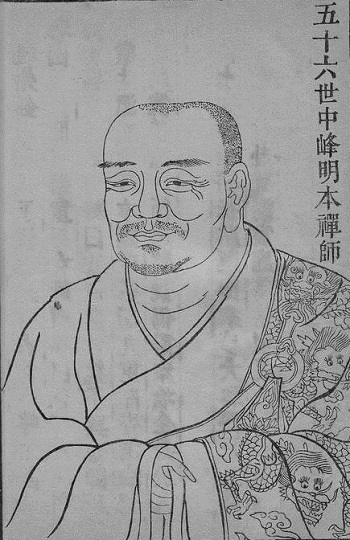
中峰明本 Zhongfeng Mingben (1263-1323)
(Rōmaji:) Chūhō Myōhon
![]()
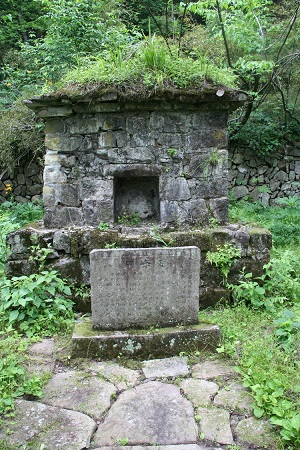
Mingben's stūpa on Mount Tianmu
PDF: Natasha Lynne Heller, Illusory abiding: The life and work of Zhongfeng Mingben (1263–1323)
Harvard University, 2005
My dissertation examines the figure of Zhongfeng Mingben, one of the most eminent Chan monks of the Yuan dynasty. While Mingben never left southeast China, he attracted followers from throughout China and from abroad. These followers were not only Buddhist monks but also elite lay men and women. Mingben refused to head large monasteries, but instead traveled and lived in the small cloistered communities that he founded in the Jiangnan region. Thus he was a figure of both religious and cultural importance but also one who stood outside the monastic mainstream. Mingben's approach to the study of Chan rejected reliance on the textual tradition and instead demanded rigorous, long-term attention to the cultivation of mind. This underlying religiosity was central to all his pursuits, in both Buddhist and literati realms. My study is divided into three parts. The first two chapters consider the context and construction of Mingben's life. Chapters three and four analyze his contributions to Chan through his teachings and through the monastic code he authored. Chapters five through seven consider Mingben in relation to his literati followers, with special attention to his use of cultural forms to convey his core teachings.
A groundbreaking monograph on Yuan dynasty Buddhism, Illusory Abiding offers a cultural history of Buddhism through a case study of the eminent Chan master Zhongfeng Mingben. Natasha Heller demonstrates that Mingben, and other monks of his stature, developed a range of cultural competencies through which they navigated social and intellectual relationships. They mastered repertoires internal to their tradition—for example, guidelines for monastic life—as well as those that allowed them to interact with broader elite audiences, such as the ability to compose verses on plum blossoms. These cultural exchanges took place within local, religious, and social networks—and at the same time, they comprised some of the very forces that formed these networks in the first place. This monograph contributes to a more robust account of Chinese Buddhism in late imperial China, and demonstrates the importance of situating monks as actors within broader sociocultural fields of practice and exchange.
Heller, N. (2014). Illusory Abiding: The Cultural Construction of the Chan Monk Zhongfeng Mingben (Harvard East Asian Monographs) (Illustrated ed.). Harvard University Asia Center.
Zhongfeng Mingben and the Case of the Disappearing Laywomen
by Natasha Heller
Chung-Hwa Buddhist Journal (2013, 26: 67-88)
PDF: "The Chan Master as Illusionist: Zhongfeng Mingben's Huanzhu Jiaxun"
by Natasha Heller
Harvard Journal of Asiatic Studies, Volume 69, Number 2, December 2009
http://www.academia.edu/2851616/The_Chan_Master_as_Illusionist_Zhongfeng_Mingbens_Huanzhu_Jiaxun
http://muse.jhu.edu/journals/jas/summary/v069/69.2.heller.html
To examine the metaphor of illusion in Chinese Buddhism, Natasha Heller focuses on “Huanzhu jiaxun” 幻住家訓 (The family instructions of “Illusory Abiding”) by the Chan monk Zhongfeng Mengben 中峰明本 (1263–1323). Considering Mingben's usage of the term “illusory” (huan ) in relation to its history in non-Buddhist and Buddhist sources, she examines how he addressed the use of language, with special reference to the Chan concept of “observing the key phrase” (kanhua). Mingben remained within the established philosophical discourse on illusion but, Heller argues, shifted away from metaphors related to the concept; instead he emphasized the character huan to suggest an alternative to intellectual analysis of words. He thereby advanced the discussion of kanhua Chan while affirming the ultimate illusoriness of such practice.
"7: Between Zhongfeng Mingben and Zhao Mengfu: Chan Letters in Their Manuscript Context"
by Natasha Heller, Buddhist Manuscript Cultures III, New York: Routledge, 2009, pp. 109–123.
PDF: Zhongfeng Mingben’s Illusory Man
Translated by William Dufficy
Introduction and footnotes by ewk
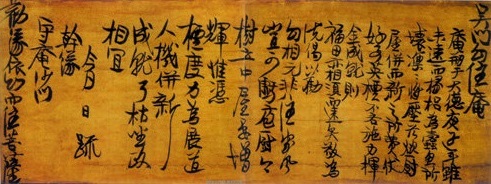
中峰明本书法(柳叶体) Zhongfeng Mingben's Calligraphy
A Master of His Own: The Calligraphy of the Chan Abbot Zhongfeng Mingben (1262-1323)
by Uta Laurer (1961-)
(Studien zur Ostasiatischen Schriftkunst, 5.) 164 pp, 43 plates. Stuttgart: Franz Steiner Verlag, 2002.
http://books.google.hu/books?id=fvVIrEt9DHYC&printsec=frontcover&hl=hu&source=gbs_ge_summary_r&cad=0#v=onepage&q&f=false
Contents
- Terminology 11
- Table of the Eight Standard Strokes of Chinese Characters 12
- I Traditions and Prerequisites of Chan Calligraphy
- 1. The Tradition of the Scholar Officials 13
- 2. Buddhist Tradition apart from Chan 20
- 3. Chan Calligraphers 28
- 4 Aesthetic Concepts in Chan Calligraphy 32
- 5. Aesthetic Concepts in Scholar Official Calligraphy 40
- 6. Some Common Points between Chan and Scholar Official
- Calligraphy 46
- II Biographical and Historical Framework
- 1. The Biography of Zhongfeng Mingben 49
- 2. Zhao Mengfu and other Literati 58
- 2.1. Zhao Mengfu 59
- 2.2. Xianyu Shu 64
- 2.3. Deng Wenyuan 67
- 2.4. Feng Zizhen 69
- 2.5. Yu Ji 71
- 2.6. Zhang Yu 72
- 2.7. Yang Weizhen 74
- 2.8. Kangli Naonao 76
- 2.9. Rao Jie 78
- 3. Zhongfeng Mingben's Buddhist Connections 79
- 3.1. Qu Tingfa 79
- 3.2. Yuan Jian 80
- 3.3. King Ch'ung-son 80
- 3.4. Chushi Fanqi 81
- 3.5. Yi'an 81
- 3.6. Jueji Yongzhong 82
- 3.7. Ka'ō Sōnen 84
- 3.8. Tesshfi Tokusai 85
- 3.9. Enkei Soyū 86
- 3.10. Muin Genkai 86
- 3.11. Gyōkai Honjō 86
- III The Oeuvre of Zhongfeng Mingben
- 1. Discussion of the Works 88
- 2. The Willow-leaf Style 89
- 3. Calligraphic Works 92
- 3.1. Portraits of Zhongfeng Mingben with Self-inscription 92
- 3.I.1. The Kōgenji Portrait 93
- 3.1.2. The Yabumoto Portrait 100
- 3.1.3. The Senbutsuji Portrait 105
- 3.1.4. The Hōunji Portrait 107
- 3.1.5. The Marui Portrait 109
- 3.1.6. Some Observations on the Spread of Zhongfeng 111
- Mingben's Image and Calligraphy
- 3.II. Inscriptions and Colophons to other Paintings 114
- 3.II. 1. Bodhidharma Crossing the Yangzi River 114
- 3.11.2 Guanyin Paintings 116
- 3.III. Sermons 119
- 3.III. 1. Sermon for Enkei Soyū 119
- 3.IV. Letters 120
- 3.IV.1. Letter to Shōkai Dōgen 120
- 3.IV.2. Subscription to Rebuild the Huanzhu Temple at Wumen 121
- 3.IV.3. Letter to Lord Otomo Sadamune 122
- 3.IV.4. Letter to Baoshi zhe 124
- 3.IV.5. Letter to Monk Sai 125
- 3.V. Sobriquets 127
- 3.V.1. Sobriquet for Huian 127
- Diamond Sutra by Zhao Mengfu with Colophon by Zhongfeng Mingben 128
- Developments in Zhongfeng Mingben's Calligraphy 130
- IV Conclusions
- 1. Zhongfeng Mingben's Pivotal Role between Literati and Chan Calligraphy 132
- 2. The Impact of Zhongfeng Mingben's Calligraphy in Japan 134
- Appendix
- Autobiography of Zhongfeng Mingben, Written when he was 60 Years old 138
- Bibliography 146.
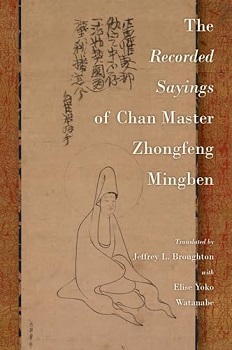
PDF: The Recorded Sayings of Chan Master Zhongfeng Mingben
by Jeffrey L. Broughton with Elise Yoko Watanabe
Oxford University Press, 2023
Contents
Abbreviations ix
Introduction 1
Linji Chan in the South During the Mongol Yuan Dynasty: Zhongfeng Mingben and Yuansou Xingduan 1
Autobiography and Huatou Chan 7
The Format and Underlying Theme of Zhongfeng’s Autobiography 10
The Confining Bureaucratic Chan Style of Mt. Tianmu Versus the Unencumbered Chan Style of a Vagabond Budai (布袋) 14
Two Chan Records for Zhongfeng Mingben: Zhongfeng Extensive Record and Zhongfeng Record B 17
Understanding the Phantasmal (zhi huan 知幻) 23
Detaching from the Phantasmal (li huan 離幻): The Huatou 27
Zhongfeng’s Great Matter of Samsara (shengsi dashi 生死大事) 30
Zhongfeng: “I Am Not Awakened” 32
Entanglement of Huatou Chan and Pure Land Nianfo (Nembutsu): Zhongfeng and Tianru 35
Zhongfeng and the “Nanzhao” (Yunnan) Pilgrim Xuanjian (玄鍳; d.u.) 38
Zhongfeng and Japanese Zen 43
Zhongfeng, Tianru, and Ming- Dynasty Linji Chan 55
Translation 1: Selections from Instructions to the Assembly in Zhongfeng Extensive Record 63
Translation 2: Selections from Dharma Talks in Zhongfeng Extensive Record 71
Translation 3: Night Conversations in a Mountain Hermitage in Zhongfeng Extensive Record 83
Translation 4: House Instructions for Dwelling- in- the- Phantasmal Hermitage in Zhongfeng Extensive Record 168
Translation 5: In Imitation of Hanshan’s Poems in Zhongfeng Extensive Record 179
Translation 6: Song of Dwelling- in- the- Phantasmal Hermitage in Zhongfeng Extensive Record 212
Translation 7: Cross- Legged Sitting Chan Admonitions (with Preface) in Zhongfeng Extensive Record 214
Translation 8: Ten Poems on Living on a Boat in Zhongfeng Extensive Record 216
Translation 9: Ten Poems on Living in Town in Zhongfeng Extensive Record 220
Translation 10: Selections from Zhongfeng Dharma Talks in Zhongfeng Record B 225
Translation 11: Instructions to the Assembly from Zhongfeng Talks in Zhongfeng Record B 245
Chinese Text for Translation 1: Selections from Instructions to the Assembly in Zhongfeng Extensive Record 247
Chinese Text for Translation 2: Selections from Dharma Talks in Zhongfeng Extensive Record 250
Chinese Text for Translation 3: Night Conversations in a Mountain Hermitage in Zhongfeng Extensive Record 254
Chinese Text for Translation 4: House Instructions for Dwelling-in-the-Phantasmal Hermitage in Zhongfeng Extensive Record 280
Chinese Text for Translation 5: In Imitation of Hanshan’s Poems in Zhongfeng Extensive Record 284
Chinese Text for Translation 6: Song of Dwelling- in- the- Phantasmal Hermitage in Zhongfeng Extensive Record 294
Chinese Text for Translation 7: Cross- Legged Sitting Chan Admonitions (with Preface) in Zhongfeng Extensive Record 295
Chinese Text for Translation 8: Ten Poems on Living on a Boat in Zhongfeng Extensive Record 296
Chinese Text for Translation 9: Ten Poems on Living in Town in Zhongfeng Extensive Record 298
Chinese Text for Translation 10: Selections from Zhongfeng Dharma Talks in Zhongfeng Record B 300
Chinese Text for Translation 11: Instructions to the Assembly from Zhongfeng Talks in Zhongfeng Record B 309
Bibliography 311
Index 315
PDF: The Definition of a Koan
by Chung-feng Ming-pen
Translated by Ruth Fuller Sasaki
In: Miura, Issho and Ruth Fuller Sasaki. Zen Dust: The History of the Koan and Koan Study in Rinzai (Lin-chi) Zen. Kyoto: The First Zen Institute of America, 1966.
Mingben's Portraits
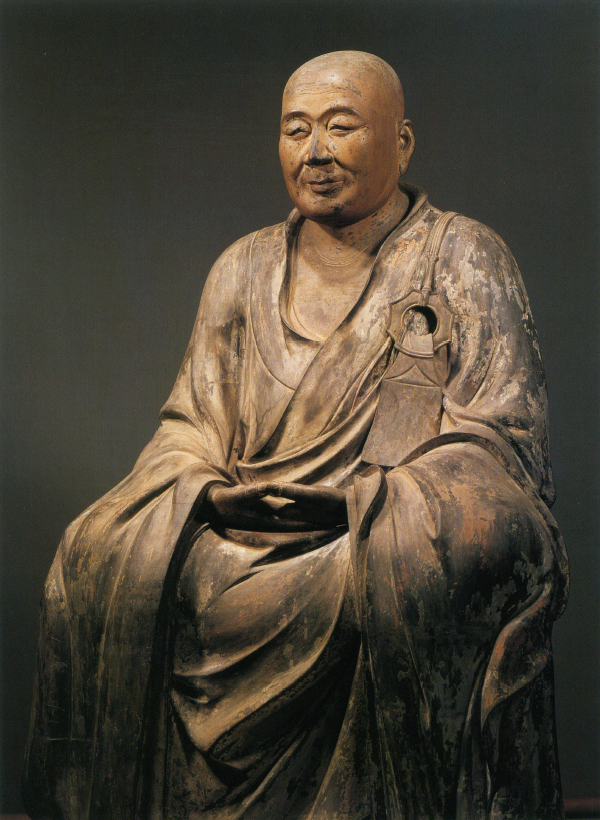
By Inko and Injun (active mid-14th century),
dated 1353.
Wood with remains of pigment.
H. 82.5 cm.
Seiunji, Yamanashi Prefecture.
Important Cultural Property, Juy6 Bunkazai.
Zhongfeng Mingben was one of the most
important and influential masters of meditation.
In China as well as in Japan, he
was highly regarded not only in Zen circles,
but also among Emperors, scholars,
poets, and artists. Among his admirers
and closest friends were the celebrated
poet Feng Zizhen (1257-after 1327) and
the great painter, calligrapher, and Han/in
scholar Zhao Mengfu (1254-1322).The well-preserved portrait statue at
Seiunji, carved out of several blocks of
Japanese cypress, hinoki, is characterized
by the marked sculptural contrast between
the smooth, sensitively modelled
face with its bright inlaid rock-crystal eyes,
gyokugan kannyu, and the agitated, powerfully
molded folds of the garment. In
several aspects, the statue is a remarkable
work of Japanese sculpture: it is of
outstanding artistic quality, a striking portrait
of the important Chinese Chan master
with all his characteristic qualities; at
the same time, it is dated and signed;
moreover, it must have been carved after
painted portraits, sketches, or reliable
eyewitness reports, for the artists never
met their model in person. Finally, the portrait
is testament to the almost limitless,
enduring popularity and reverence enjoyed
by Zhongfeng Mingben among Japan's
medieval Zen circles.Most likely the sculpture was commissioned
by the Zen abbot Gōkai Honjō
(died 1352). Together with several other
Japanese pilgrim monks, among them
Enkei Soyū (1285-1344) and Mu'in Genkai
(before 1310-1358), Gōkai Honjō had
been in China from 1318 until 1326, where
he studied under Zhongfeng Mingben.
Emulating his revered meditation master,
in 1348 Gōkai Honjō built a monastery in a
secluded valley of the old province Kai on
a mountain that he named Tenmokuzan
(Chin. Tianmushan). He called his new
Zen institution "Monastery to Live in the
Clouds", Seiunji, expressing his wish to be
living undisturbed in solitary reclusion.
Perhaps, Gokai Honjo intended to consecrate
a portrait statue in his new residence
at the occasion of the thirtieth anniversary
of the great Chinese master's death,
which was also his ninetieth birthday, for
the sculpture was completed on the ninth
day of the fourth month in 1353.This information is given in a red inscription
inside the neck of the separately
carved head. The two sculptors are identified
by their ecclesiastical ranks and
names: Hokkyō, "Dharma Bridge", Injun
and Hōgen, "Dharma Eye", Inkō. The
statue is thus the joint work of the two
Buddhist sculptors or busshi, who are
also responsible for the Sakyamuni statue
at the same monastery. Other statues
extant by Inkō are an image of the
Bodhisattva Fugen dated to 1347 at
Hozoji in Tochigi Prefecture, and a Hōkan
Amida figure of 1349 at Zendōji in
Fukuoka.Gokai Honjō did not live to inaugurate the
Zhongfeng Mingben statue at Seiunji himself.
He died on the 27th day of the seventh
month of 1352, nine months prior to
the completion of the work. A portrait
sculpture at Seiunji also dated 1353 is a
memorial to the founding abbot. While still
alive, Gōkai Honjō probably supplied the
two Japanese sculptors with reliable
material concerning the famous Chinese
master of meditation, perhaps even a
chinzō he may have received from Mingben
himself. Otherwise, the artists could
hardly have known such details as
Mingben's missing small finger of his left
hand, burned off as a Buddha sacrifice.Zen - masters of meditation in images and writings
by Helmut Brinker [1939–2012]; Hiroshi Kanazawa [金沢 比呂司 1937-]
Museum Rietberg; Artibus Asiae, Zürich, 1996, p. 242.
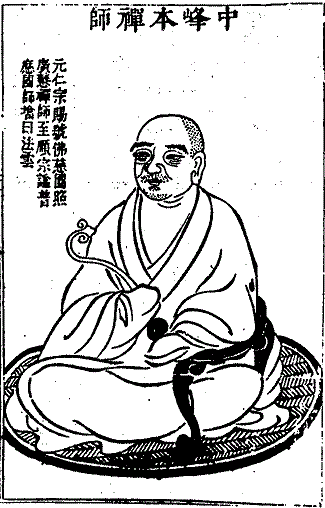
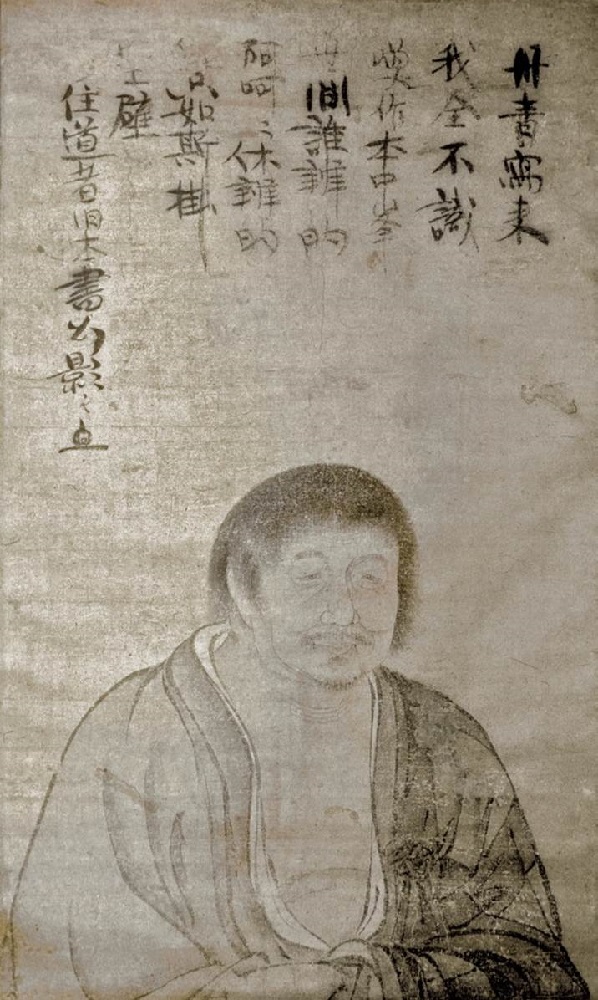
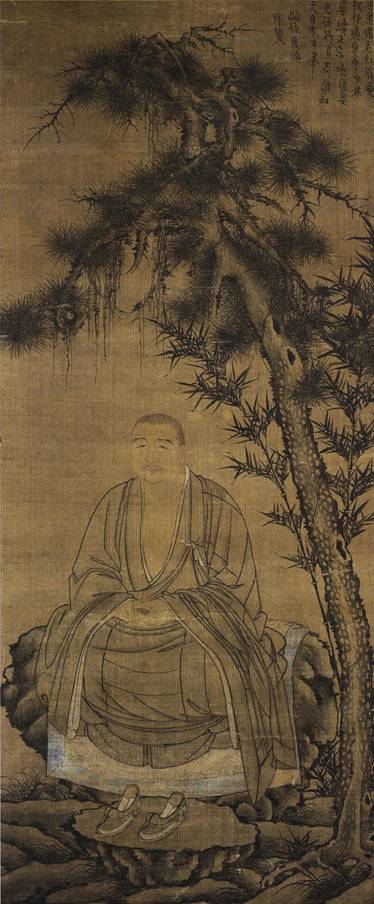
Portrait of the Chinese Chan Master Zhongfeng Mingben (1263-1323) in Meditation under a Pine Tree
Anonymous. Inscription by Guangyan (14th century?).
Hanging scroll. Ink and light colours on silk.
123.5 x 51.2 cm.
Shôkoku-ji, Jishô-in, Kyoto
This portrait of Zhongfeng Mingben is
unsigned and without any seals of the
artist. It shows the corpulent Chan abbot
seated with crossed legs on a rock, the
hands in his lap in the "seal of meditation",
zenjo'in. Mingben's robe is wide open at
the chest, as in other portraits of him. The
rock is covered with a precious textile, and
his shoes are placed on a smaller rock in
front of him. The ground is uneven and
partly covered with grass. On the right
side, a magnificent pine tree and two
bamboo stalks lean over the master like a
canopy. It seems as if the Chinese Chan
master had selected and prepared an
ideal place for meditation in the calm of
nature.
An inscription in the upper right corner of
the scroll probably was added later by an
unidentified monk called Guangyan, one
of Mingben's numerous disciples:Old Huanweng [Zhongfeng Mingben] here loved pines and bamboo.
He received and maintained [Bodhidharma's tradition of] Shaolin[si].
To continue roughly his true school, no matter how far-reaching,
His heirs will have to shoulder responsibility.
[But] who knows [Mingiben Zhongfeng from Tianmu[shan]?
His follower Guangyan reverently [wrote] this eulogy.Evidently, this unorthodox open-air portrait
of Zhongfeng Mingben reminded
Guangyan of the great founding patriarch
Bodhidharma whose celebrated episode
of nine-year uninterrupted cliff contemplation
took place at Shaolinsi. The second
line of the poem mentions the monastery
on Mt. Song north of Dengfeng in presentday
Henan Province, founded in 496 by
Emperor Xiaowen (reigned 471-499) of
the Northern Wei Dynasty. A simple
shrine, Mianbi'an or "Facing-the-Wall Hermitage",
to the northwest of the monastery
preserves the memory of the origin of
Chan Buddhism in China.
The discrepancy in style between the figure
and the landscape seems to indicate
that two painters collaborated on the
composition. While the rocks and grasses,
the pine and the bamboo are painted with
vigour and fantasy, the somewhat stiff figure
- rendered with even "iron wire lines",
tiexian miao (Jap. tessenbyb) - is painted
in slavish adherence to the preliminary
drawing that is partially visible.
Such joint works, hezuo, were quite common
among literati circles of the Yuan
Dynasty. The pine tree and the bamboo in
this portrait bear a striking resemblance to
the style of Li Shixing (1283-1328) and,
even more so, of his father, Li Kan (1245-
1320). The latter was greatly admired by
Zhao Mengfu (1254-1322) as is vouched
for by his colophons and eulogies on Li's
bamboo paintings. On the other hand,
Zhao was a close friend of Zhongfeng
Mingben, as witnessed by six extant letters
of Zhao to Mingben dating to ca. 131 1.
Moreover, there exists in Taipei a copy by
the Qing Dynasty painter Pan Gongshou
(1741-1794) of a painting showing Mingben
as portrayed by Zhao Mengfu in 1309.
Most likely, this was not the only likeness
Zhao made of his abbot friend. It is thus
not far-fetched to suggest that such a
work or a sketch by Zhao Mengfu might
have served as the model for the portrait
at Jishb'in. The anonymous artist might
have faithfully copied his model, meticulously
clinging to every line. To some
degree this would also explain the stiffness
of the brushwork.
If one is to accept the collaboration of two
artists and perhaps even the active participation
of Zhao Mengfu and Li Kan, or
members of their circle, several questions
remain unanswered. Since Zhongfeng
Mingben survived both artists by a few
years, the painting must have been done
during his lifetime. In that case, however,
the sitter should - according to orthodox
rules of Chan portraiture - look toward the
right. But this highly unconventional Mingben
portrait was probably not intended to
be presented to a disciple confirming his
advanced stage of spiritual perception or
his legitimate place in the master's line of
succession. It was perhaps simply done
to demonstrate the Chan abbot's love for
nature. Mingben preferred to lead the life
of a religious recluse among bamboo,
rocks, and old trees, unhampered by the
organized hierarchy of his school in major
busy meditation centres. The portrait may
have been done for the abbot's or the
painters' own amusement. One may see it
as an enchanting, complex mirror image
of the character of an unconventional hermit
monk, maybe even as a token of close
friendship between congenial personalities
of the Yuan Dynasty.Zen - masters of meditation in images and writings
by Helmut Brinker [1939–2012]; Hiroshi Kanazawa [金沢 比呂司 1937-]
Museum Rietberg; Artibus Asiae, Zürich, 1996, p. 252.
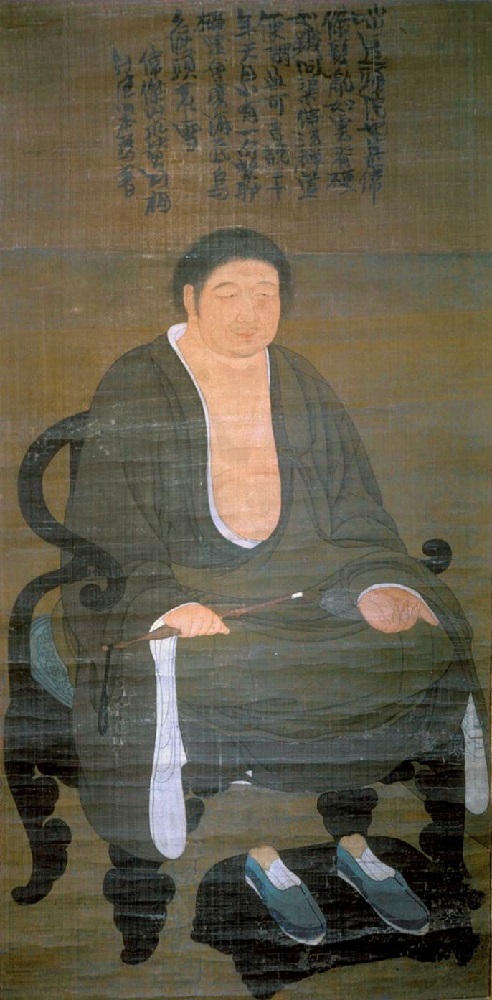
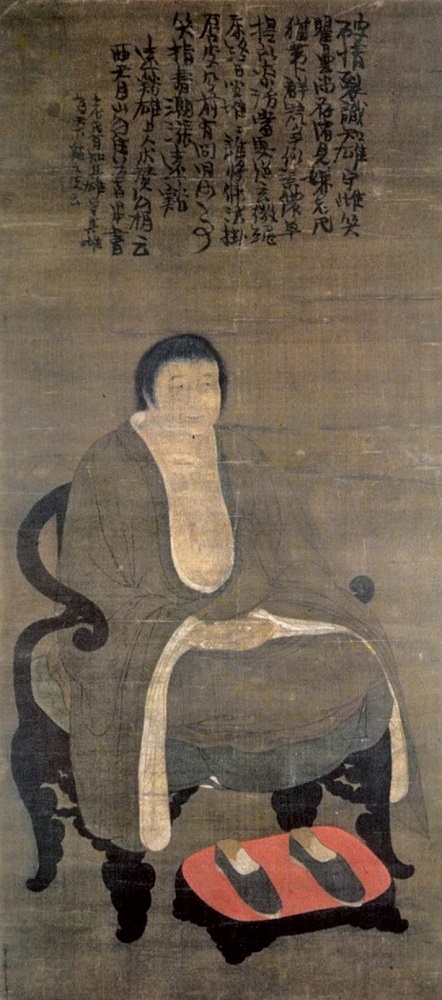
Portrait of Zhongfeng Mingben 中峰明本像,
121.9cm × 54.4cm,
early 14th century 14 世 纪初,
Kyōto 京都, Senbutsu-ji Temple 選仏寺
Zhongfeng Mingben was the youngest of seven children of the Sun family in Qiantang in
today's Zhejiang Province.366H e is said to have been exceptionally serious-minded
157
already as a small boy, to have had a preference for the "lotus seat" position, to have
sung Buddhist hymns, and - to the astonishment of the neighbours - to have celebrated
Buddhist rituals as children's games. When Mingben was nine years old his mother died,
and the highly gifted child left school. Some years later he began to subject himself to
rigorous ascetic exercises in addition to the daily routine of a Buddhist lay follower, such
as the reciting of holy texts. Often he would climb Mt. Lingdong to meditate alone in the
seclusion of nature. Because he wanted to remain awake even at night during his spiritual
exercises at home, he kept walking around; when he felt drowsy, he would hit his
head on the pillars of the house.
At the age of fourteen, Mingben sacrificed - following shining examples of the past - a
part of his body to the Buddha by burning off the small finger of his left hand. Earlier the
second patriarch Huike had severed and sacrificed his arm, and the customs of "burning
off a finger", ranzhi, and of inflicting fire scars on the body, shaoba, especially on the
chest with sticks of incense, have been practiced by fervent Buddhist monks for centuries
to the present day.367 Self-mutilation and self-immolation were considered a higher
level of religious enthusiasm and devotion. There are frequent references in early
Buddhist texts to bodily sacrifices of the Tathagata himself. Stūpas and monasteries were
built to commemorate these noble deeds. The learned medieval Buddhist biographer
Zanning (919-1001) commented in his introduction to section 7 entitled "Discarding the
Body" of his Song gaoseng zhuan with the following verse on this concept of physical
self-destruction:To give away the thing that is difficult to part with,
Is the best offering among the alms.
Let this impure and sinful body,
Turn into something like a diamond.368
At about the age of twenty, Mingben met the severe master of meditation Gaofeng
Yuanmiao (1238-1295) who lived in the inaccessible "Death Pass", Siguan, on top of Mt.
Tianmu in modern Zhejiang Province. To his great surprise, the eminent prelate - reputed
to be highly dismissive - was immediately willing to accept him as novice. But Mingben's
father would not consent and the young man had to content himself with studying as a
lay brother under the Chan teacher for three years. In 1287, Mingben finally received tonsure
from Gaofeng Yuanmiao in the "lion's den", the Shizizhengzongsi, "Monastery of the
True School on the Lion's Rock", thanks to the support of the pious lady Yang Miaoxi who
donated the monk's robes and other paraphernalia. She became such an ardent admirer
of the young Chan monk that at home she worshiped some strands of Mingben's hair
shaved off at tonsure. After some time the hair allegedly produced lustrous five-coloured
?arira and these are said to have rapidly increased in number. Eleven years after
Mingben's death, in the winter of 1334, a stupa was built at the "Cloud Abode", the
Yunju'an near Hangzhou, to house the Chan master's miraculous hair together with the
venerated relics that had grown from it.Two years after receiving the tonsure, Zhongfeng Mingben had already attained enlightenment.
In order to celebrate and to certify this attainment Gaofeng Yuanmiao gave him
a portrait of himself with the following eulogy:My face is inconceivable,
Even Buddhas and patriarchs cannot have a glimpse,
I allow this no-good son alone
To have a peep at half of my nose.369Mingben remained in the monastery until 1295, serving in a number of various monastic
offices. But he felt increasingly constricted and limited by the obligations of monastic life.
When his master felt death approaching he asked Zhongfeng Mingben to assume the
leadership of the newly-erected "Monastery of the Great Enlightenment", Dajuesi, built on
"Lotus Blossom Peak", Lianhuafeng, of western Mt. Tianmu with the help of a wealthy
patron. Mingben, however, declined and suggested another disciple as successor. After
the funeral of his master, he left Tianmushan and began a free, restless life of roaming
about more suited to his eccentric, individualistic character and his craving for personal
independence. Mingben wanted to be a true mendicant. From 1298 onwards, he erected
a number of hermitages which he often called Huanzhu'an, "IllusoryA bode". Repeatedly,
he rejected honourable calls to direct renowned Chan institutions. In 1304, he settled
near the grave of his teacher Gaofeng Yuanmiao, and a year later, urged by the authorities
and his ever-increasing flock of disciples, Mingben accepted the abbacy of his old
home monastery on Mt. Tianmu. In 1309, he retired to a house boat in Yizhen, Jiangsu
Province. He was recalled to Tianmushan in the following year, but in 1311 he eschewed
all clerical obligations again and withdrew to a boat on Wujiang, a river flowing into the
"Great Lake", Taihu. Subsequently, he tried to live incognito in various places, avoiding
official summonings.Despite high courtly honours and titles, and despite a large number of devoted disciples
who kept tracking him down, shunning no difficulties or dangers in their efforts to receive
religious instruction from the master, Zhongfeng Mingben could not be persuaded to live
in a monastery for any extended time until an advanced age. Repeatedly, he spurned
prestigious appointments and even an audience with the Emperor. At the bottom of his
heart, he was an individualist and a hermit. Again and again, he vanished into small, idyllic
hermitages and returned only sporadically to his home monastery as well as to a
Huanzhu'an on western Mt. Tianmu built for him in 1317 by a lay adherent called Jiang
Jun. Not until the age of fifty-five did Mingben reconcile himself to the fact that he had to
take on the burden of an abbacy: in 1318, he started shaving his head again in accordance
with monastic custom (Fig. 113). This change of his outer appearance may also
have had something to do with the monastic behaviourc odex Huanzhuq ingguit, he
"PureR ules fromt he Huanzhu[an]w" rittend own in the previousy ear and meant not so
much as generally binding order rules, but rather as a practical manual for his own circle
of disciples. He died in 1323 at the relatively early age of sixty.
In his doctrine and the practical education of his disciples, Zhongfeng Mingben emphasized
the central significance of the huatou (Jap. watō), the concentration on the "word
head", the critical phrase and essential core of a gong'an or kdan. For Zen practitioners
in his line gong'an as regular part of instruction came to represent the true essence of
meditative vocation. The master himself called gong'an a "senseless and tasteless
phrase", wuyiwei huatou, which was made up to stop the adept's excessive intellectual
approach and to artificiallyc reate the "great doubt", dayi. He left behind a number of sermons,
individual didactic sayings, commentaries to Buddhist texts, essays, poems, letters,
and painting inscriptions compiled by a disciple in the Zhongfeng Heshang guanglu
as well as a three-part supplementary volume.Zen - masters of meditation in images and writings
by Helmut Brinker [1939–2012]; Hiroshi Kanazawa [金沢 比呂司 1937-]
Museum Rietberg; Artibus Asiae, Zürich, 1996, pp. 157-159.
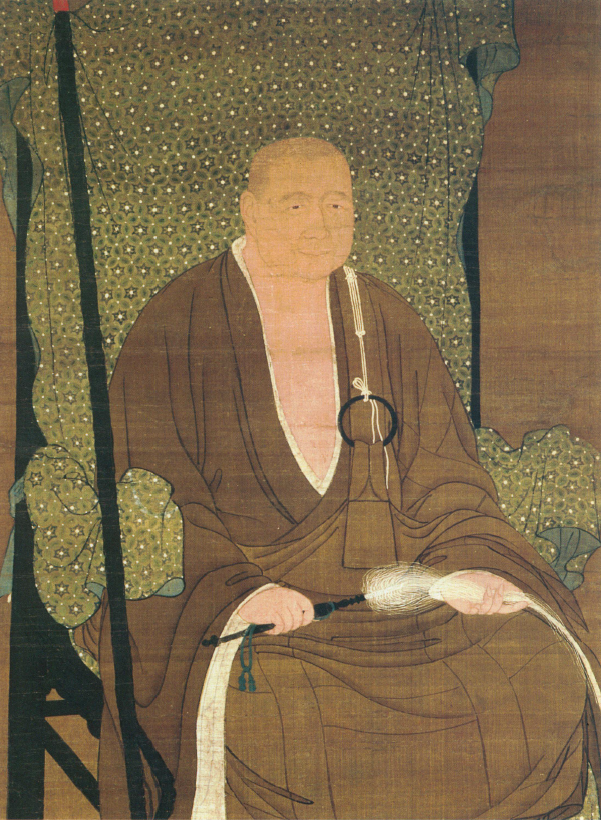
Portrait of the Chinese Chan Master Zhongfeng Mingben (1263-1323)
Anonymous. Inscription by Zhongfeng Mingben.
Hanging scroll. Ink and colours on silk.
125.2 x 51.9 cm.
Senbutsuji, Kyoto.
Important Cultural Property, Jūyō Bunkazai.
Many literary sources and extant portraits
characterize Zhongfeng Mingben as a
highly unconventional, original personality.
Among Japanese pilgrim monks he was
one of the most popular Zen teachers and
a number of his portraits made their way
to Japan as early as the beginning of the
fourteenth century. Thus, the Zen monk
Enkei Soyū (1285-1344) returned to
Japan in 1315 from a nine-year stay in
China, bringing with him an image of his
master signed by the otherwise unknown
portraitist Yi'an. In 1325, Enkei built the
Kōgenji in his native province of Tanba,
and the monastery still owns the magnificent
portrait of the important Chan master.
The main difference between the early
and later portraits of the master is that in
the former he is not shown with a shaven
head. His dark hair hangs into his forehead,
over the ears, and down his short
neck. He seems to have adopted this
unconventional and not very clerical haircut
from his master Gaofeng Yuanmiao
(1238-1295). Only from 1318 on, when
Zhongfeng Mingben gave up his role as
itinerant hermit-monk and accepted the
honourable post of a Chan abbot, did he
shave his head in accordance with the
order's rules.This is how Zhongfeng Mingben is shown
in the portrait at Senbutsuji in Kyōto. As it
is inscribed by the portrayed abbot, it
probably dates to between 1318 and
1323. In its composition with the master
turned slightly to the right, the painting is
in accordance with the conventional type
of Zen portrait painted during the lifetime
of the prelate. In such images, the master
appears in the dignified regalia of his office,
seated in the abbot's chair, yizixiang
(Jap. isuz6), "image in the chair". The corpulent
abbot is seated with crossed legs
in meditation pose, his robe falling down
over his knees. In front of the chair, his
shoes are standing on a footstool with
short, ornamented feet. His brown monk's
robe hangs loosely around his round
shoulders, comfortably open from the
chest to his stomach. At the seam of the
collar and the sleeves, a white under-garment
is visible. A black ring over Mingben's
heart, fastened with a white cord
over the shoulders, holds his stole, kesa.
On the left, a long priest's staff, bang (Jap.
bō), with red ends leans against the ornamental
cloth covering the back rest of the
abbot's chair. In his hands, the abbot
holds a whisk, fuzi (Jap. hossu), another
symbol of his rank as abbot. Originallyt, he
fly whisk was intended to chase away
molesting insects during meditation; metaphorically,
however, it came to signify the
sweeping away of all doubts, worldly
thoughts, and desires; the symbol for
purity of heart, for the removing of "dust
from the mirror of the mind", as the patriarchs
put it. At his left hand, the mutilated
little finger is clearly visible: as young, passionate
follower of the Buddhist creed, he
had burned it off, to present it as a sacrifice
to Buddha. Zhongfeng Mingben's
round, full face with the small, narrow eyes
emanates benevolent understanding, his
overall posture composed authority.The linear vocabulary of this portrait, typical
of one aspect of figure painting during
the Yuan Dynasty, is fundamentally different
from the modulated, swelling and
ebbing calligraphic line of the Song Dynasty.
The evenly flowing, thin "iron wire
lines", tiexian miao (Jap. tessenbyō), of the
garment are partly accompanied by light
shadings adding modulation to the folds.The inscription by Zhongfeng Mingben is
partly illegible due to fire damage, and it is
not to be found in his "Recorded Sayings".
The date and the recipient of the portrait
are therefore not known. However, some
conjectures can be made. Originally, the
scroll was at Genjū'an of Nanzenji in
Kyoto, where Mu'in Genkai (before 1310-
1358), a former disciple of the portrayed
abbot, was appointed 21 st abbot in 1349.
In 1326, three years after the death of his
master on Mt. Tianmu near Hangzhou,
Mu'in Genkai had returned to Japan,
together with a group of monks among
whom was Qingzhuo Zhengcheng (1274-
1339). Therefore it is not impossible that
Mu'in Genkai, the future Nanzenji abbot,
carried the portrait of Zhongfeng Mingben
in his luggage.A document accompanying of the work
explains why the scroll had to be newly
mounted in 1538: the scroll had been
stored in the library of Nanzenji, where
there had been a fire shortly before 1538.
On the day after the accident, a monk had
found the rolled-up scroll in the ashes.
Miraculously, only the outer layers of the
scroll, i.e., the inscription in the upper,
"outer" part, were damaged; the lower,
"inner" parts, however, with the actual
portrait, were left undamaged.Zen - masters of meditation in images and writings
by Helmut Brinker [1939–2012]; Hiroshi Kanazawa [金沢 比呂司 1937-]
Museum Rietberg; Artibus Asiae, Zürich, 1996, p. 250.
![]()
Ming-pen
In:
Buddha tudat, Zen buddhista tanítások. Ford., szerk. és vál. Szigeti György, Budapest, Farkas Lőrinc Imre Könyvkiadó, 1999, 103. oldal
Démonok birodalma
A zen a tudat tiszta földjének tanítása. Ha meg akarod
érteni az élet-halálról szóló mély értelmű tanítást, ak-
kor be kell látnod, hogy a kétség vagy a zavarodottság
egyetlen gondolata nyomban a démonok birodalmába
taszít téged.
Csak higgy magadban!
Csak higgy magadban!
A tudat valójában tiszta
A tudat valójában tiszta és nyugodt, alapvetően rnen-
tes minden szennyeződéstől.
Meditáció
Ha meditációd közben gondolatok kavarognak a fejed-
ben, és az elképzeléseid összezavarnak, akkor ne foglal-
kozz velük egyáltalán, függedenül attól, hogy azok jók
vagy rosszak, igazak vagy hamisak.